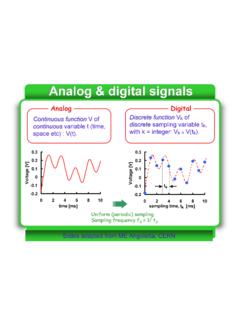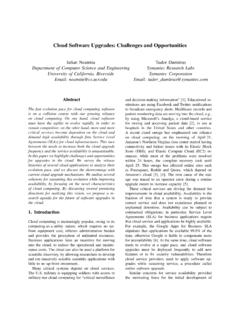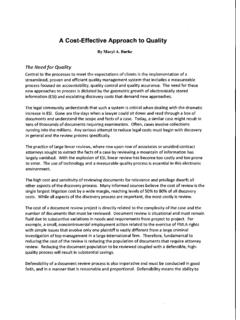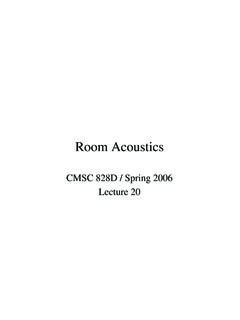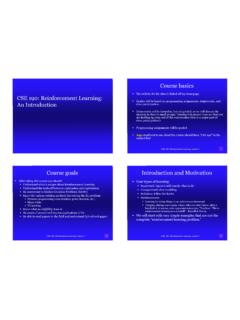Transcription of Reinforcement Learning: An Introduction - umiacs.umd.edu
1 IReinforcement Learning: An IntroductionSecond edition, in progress**Draft**Richard S. Sutton and Andrew G. Bartoc 2014, 2015A Bradford BookThe MIT PressCambridge, MassachusettsLondon, EnglandChapter 9On-policy Prediction withApproximationWe have so far assumed that our estimates of value functions are represented as atable with one entry for each state or for each state action pair. This is a particularlyclear and instructive case, but of course it is limited to tasks with small numbers ofstates and actions. The problem is not just the memory needed for large tables, butthe time and data needed to fill them accurately. In other words, the key issue isthat ofgeneralization. How can experience with a limited subset of the state spacebe usefully generalized to produce a good approximation over a much larger subset?
2 This is a severe problem. In many tasks to which we would like to apply reinforce-ment learning , most states encountered will never have been experienced exactlybefore. This will almost always be the case when the state or action spaces includecontinuous variables or complex sensations, such as a visual image. The only wayto learn anything at all on these tasks is to generalize from previously experiencedstates to ones that have never been , generalization from examples has already been extensively studied,and we do not need to invent totally new methods for use in Reinforcement a large extent we need only combine Reinforcement learning methods with ex-isting generalization methods.
3 The kind of generalization we require is often calledfunction approximationbecause it takes examples from a desired function ( , avalue function) and attempts to generalize from them to construct an approximationof the entire function. Function approximation is an instance ofsupervised learning ,the primary topic studied in machine learning , artificial neural networks, patternrecognition, and statistical curve fitting. In principle, any of the methods studied inthese fields can be used in Reinforcement learning as described in this Value-Function ApproximationAs usual, we begin with the prediction problem of estimating the state-value functionv from experience generated using policy.
4 The novelty in this chapter is that the195196 CHAPTER 9. ON-POLICY PREDICTION WITH APPROXIMATION approximate value function is represented not as a table but as a parameterizedfunctional form with parameter vector Rn. We will write v(s, ) v (s) for theapproximated value of statesgiven parameter vector . For example, vmight be thefunction computed by an artificial neural network, with the vector of connectionweights. By adjusting the weights, any of a wide range of different functions vcanbe implemented by the network. Or vmight be the function computed by a decisiontree, where is all the parameters defining the split points and leaf values of thetree. Typically, the number of parametersn(the number of components of ) is muchless than the number of states, and changing one parameter changes the estimatedvalue of many states.
5 Consequently, when a single state is backed up, the changegeneralizes from that state to affect the values of many other of the prediction methods covered in this book have been described as backups,that is, as updates to an estimated value function that shift its value at particularstates toward a backed-up value for that state. Let us refer to an individual backupby the notations7 g, wheresis the state backed up andgis the backed-up value,or target, thats s estimated value is shifted toward. For example, the Monte Carlobackup for value prediction isSt7 Gt, the TD(0) backup isSt7 Rt+1+ v(St+1, t),and the general TD( ) backup isSt7 G t. In the DP policy evaluation backups7 E [Rt+1+ v(St+1, t)|St=s], an arbitrary statesis backed up, whereas in theother cases the state encountered in (possibly simulated) experience,St, is is natural to interpret each backup as specifying an example of the desiredinput output behavior of the estimated value function.
6 In a sense, the backups7 gmeans that the estimated value for statesshould be more likeg. Up to now, theactual update implementing the backup has been trivial: the table entry fors sestimated value has simply been shifted a fraction of the way towardg. Now wepermit arbitrarily complex and sophisticated function approximation methods toimplement the backup. The normal inputs to these methods are examples of thedesired input output behavior of the function they are trying to approximate. Weuse these methods for value prediction simply by passing to them thes7 gof eachbackup as a training example. We then interpret the approximate function theyproduce as an estimated value each backup as a conventional training example in this way enables us touse any of a wide range of existing function approximation methods for value pre-diction.
7 In principle, we can use any method for supervised learning from examples,including artificial neural networks, decision trees, and various kinds of multivariateregression. However, not all function approximation methods are equally well suitedfor use in Reinforcement learning . The most sophisticated neural network and statis-tical methods all assume a static training set over which multiple passes are Reinforcement learning , however, it is important that learning be able to occur on-line, while interacting with the environment or with a model of the environment. Todo this requires methods that are able to learn efficiently from incrementally acquireddata. In addition, Reinforcement learning generally requires function approximationmethods able to handle nonstationary target functions (target functions that VALUE-FUNCTION APPROXIMATION197over time).
8 For example, in GPI control methods we often seek to learnq while changes. Even if the policy remains the same, the target values of training ex-amples are nonstationary if they are generated by bootstrapping methods (DP andTD). Methods that cannot easily handle such nonstationarity are less suitable forreinforcement performance measures are appropriate for evaluating function approximationmethods? Most supervised learning methods seek to minimize the mean squared error(MSE) over some distribution over the inputs. In our value prediction problem, theinputs are states and the target function is the true value functionv . Given aparameter vector, we seek to minimize the expected squared difference between thevalue estimates of the vector and the true values, which we call themean squarevalue error(MSVE):MSVE( ) = s Sd(s)[v (s) v(s, )]2,( )whered:S [0,1], such that sd(s) = 1, is a distribution over the states specifyingthe relative importance of errors in different states.
9 This distribution is importantbecause it is usually not possible to reduce the error to zero at all states. After all,there are generally far more states than there are components to . The flexibility ofthe function approximator is thus a scarce resource. Better approximation at somestates can be gained, generally, only at the expense of worse approximation at otherstates. The distribution specifies how these trade-offs should be distributiondis also usually the distribution from which the states in thetraining examples are drawn, and thus the distribution of states at which backupsare done. If we wish to minimize error over a certain distribution of states, thenit makes sense to train the function approximator with examples from that samedistribution.
10 For example, if you want a uniform level of error over the entire stateset, then it makes sense to train with backups distributed uniformly over the entirestate set, such as in the exhaustive sweeps of some DP methods. Henceforth, let usassume that the distribution of states at which backups are done and the distributionthat weights errors,d, are the distribution of particular interest is the one describing the frequency with whichstates are encountered while the agent is interacting with the environment and se-lecting actions according to , the policy whose value function we are call this theon-policy distribution, in part because it is the distribution of back-ups in on-policy control methods. Minimizing error over the on-policy distributionfocuses function approximation resources on the states that actually occur while fol-lowing the policy, ignoring those that never occur.
